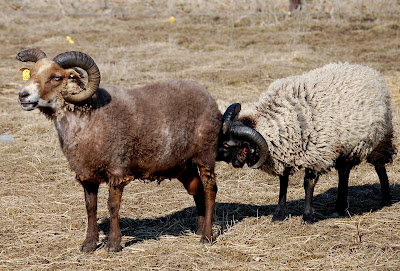Well, this wacky 'Winter' weather, or lack thereof, has become evident not only in the continued growth of many of the plants and trees in this area, but also in the ridiculously early - loosening fleece on some of my sheep. I had already decided to schedule shearing a bit earlier than usual this Spring, but some of the sheep won't be able to wait much longer without losing a good portion of their fleece.
How can I tell that the sheep are ready to roo, you might ask? What is rooing, you might ask? Why don't you just tell us, you might ask?
Well, when you look at the sheep you can tell which are starting to 'roo' ( shed their fleece), because they look like milkweed pods ready to release their seeds!
If you are new to my blog, you might need to know that I have an over-active imagination...you'll get used to it after a while. I am kind of an acquired taste.
Milkweed....
...... and Avyt, the ram.
Notice that there are clumps of fleece that stick up higher than the rest? Some of the primitive breeds of sheep will roo their fleece in this manner - as I find with many of my finer-fleeced Shetlands. Not all of them do this, but I have a few that do. This is what is referred to as "the rise", when a natural break occurs between the old growth from last year's fleece, and the new growth from the current season. Fleece that starts to loosen like this can be very easily plucked, or pulled off of the sheep rather than shearing in the conventional way, and rooing can be much less stressful for the sheep than shearing....and kind of fun too! For me anyway....I don't get out much.
So, after capturing Avyt, I haltered him and tied him to the fence so that he would stand nicely for me.
Little by little, bunch by bunch, the fleece came off.
Clean and soft, and no second cuts like you get when you shear.
"Ummmmm... Dude, I don't mean to be rude, but I don't know if that's a good look for you."
After less than an hour, we were all finished.
"What in the heck did she do to you anyway??"
There is just enough of the new growth left on the sheep to help keep him warm, and of course I stuffed their barn full of clean straw, just in case we get any cold weather.
And here are the fruits of my labor. A nice bag full of soft, clean, fine fleece without a single piece of VM. Absolutely gorgeous!
"Are you SURE I look okay?"
Now, if you are more skillful than myself, like the ladies at Under The Son Farm in Indiana, you would be able to remove the fleece in one big roll as they demonstrate in this Rooing video . There is more info on this website as well.
Now I'll have to see if I can get a couple of the ewes rooed before the shearer comes to do the rest of the flock.












5 comments:
He looks GREAT Corrine! I don't think I've ever had one roo so completely. There's usually a spot or an area where the wool just isn't ready to come off.
I prefer to roo lock by lock because that way any VM falls out. If you do the whole fleece in one piece you could still have trapped VM ~ just like when shearing.
Happy Spring!
he does look great I agree!!!
Mine are doing the same, but I'm too afraid to go ahead and roo them. Technically, there's two more months of winter possible here. My luck, there'd be a blizzard next week.
Who knew. I have wondered what happened to wild sheep who aren't sheered. Do the non-rooable ones have self-limiting length fleece?
Here's another youtube video where the farm owner has people (think Tom Sawyer whitewashing he fence) come and roo. I would be a little worried about the sheep being handled gently enough, though:
http://www.youtube.com/watch?v=nsmPBfWFVf4
That is so neat! I didn't know that happened. You must be good at it because it takes me over an hour to pull my rabbit's fur and you did your sheep in one hour.Oh your the reason we are getting some snow.
Post a Comment